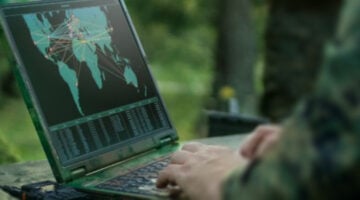
Photo from YouTube video (https://www.youtube.com/watch?v=J6TVZnVLPx8)
The USS Dwight D. Eisenhower Carrier Strike Group (CSG) and the French Charles de Gaulle CSG are cooperating at levels of integration rarely achieved in the past. Indeed, “it is at the request of US CENTCOM Commander Gen. Kenneth F. McKenzie to the French Army deputy commander for Air-Land operations (SCOAT for ‘’sous chef des opérations aéroterrestres de l’armée de Terre’’) that the French Air Naval Group (GAN for ‘’groupe aéronaval’’) assume command of US Naval Forces Central Command (NAVCENT)’s Task Force (CFT) 50 from March 31st till April 24th’’, explains a French military officer.
The U.S. initiative comes in the aftermath of a multilateral surface, air and sub-surface training exercise between the US, French, Belgian and Japanese navies called GASWEX (Group Arabian Sea Warfare Exercise). Also led by the French Navy, GASWEX took place in the Gulf of Aden between March 19 and March 22. The U.S. request came several weeks before warships were delayed by the six-day Suez Canal obstruction caused by the container ship Ever Given.
Naval Solidarity At Its Best
Such interoperability is quite good news not only from a pure military point of view within a coalition of allies, but also sends a strong political message about the close ties between these nations. “France belongs to the ‘happy few’ entrusted by the US to take over the command of their own Task Force in order to ensure stability in the region,” the French officer notes. He emphasized that both countries “share the very same vision of the terrorist threat in this area of the globe’’.
If it is common naval procedure for single ships to join forces with CTF50 – that was the case as far as the French Navy is concerned with FDA (air defense frigate) Forbin, FAA (anti-air frigate) Jean Bart, FREMM (multi-mission frigate) Auvergne in 2017. It is only the second time that the French carrier will serve as flagship of CTF50. The USS Eisenhower takes over towards the end of the month.
The first time France commanded the CTF50 lasted four months between December 2015 and March 2016 during Operation Arromanches II. Today’s mission remains the same as five years ago, the fight against ISIS. Today’s threat is of course not as strong as in 2015. Yet, it is far from over as ISIS jihadists, while in hiding underground, are still conducting attacks to destabilize northern Iraq and Syria. Situational awareness, as well as naval air strikes, are crucial to counterterrorism affecting both the Persian Gulf region as well as Europe (and even Africa, as the recent events in Mozambique unfortunately remind us).
In addition to the fight against Daesh, the French naval presence strategy promotes these principles, the military officer said: “de-escalation with Iran; contribution to lower tensions in the region; freedom of navigation, with an eye on the proliferation of NRBC weapons and the increasing drones and missiles threat.”
A Show Of Force As ‘’Refined As Possible’’
The composition of the Eisenhower CSG includes mostly Arleigh Burke-class guided-missile destroyers (the USS Thomas Hudner, the USS Mahan, the USS Mitscher and the USS Laboon) and a guided-missile cruiser (the USS Monterey).
The Charles de Gaulle CSG includes the multi-mission frigate FREMM Provence, the Air Defense frigate FDA Chevalier Paul, the Command and Support ship BCR (for ‘’Bâtiment de commandement et de ravitaillement’’) Var, as well as the Belgian frigate Leopold 1. Air surveillance assets — a Hawkeye and an ATL2 — are also part of the capabilities available with a fleet of naval Rafale that, the French ministry of the armed forces indicated, can be “catapulted every 30 seconds from the aircraft carrier.”
The CSG – GAN in French – is a part of four-month deployment which started in Toulon on February 21st and stayed in the Mediterranean till March 6th before crossing the Suez canal with the Egyptian Gowind-class Fregate El Fateh and starting a new phase of the deployment in the Red Sea. Now in the second part of the mission called Clémenceau 21 (a remake of Clémenceau 19), the TF 473 will eventually reach the Indian Ocean.
In addition to Belgian and US ships (the USS Donald Cook), the group includes other naval allies such as Greece (Spetsai-class Frigate Kanaris). In terms of means it is also composed of helicopters (Caïman Marine NH90 and Dauphin Pedro) and a nuclear attack submarine, allowing to do multiple types of multilateral exercises along the way, such as the previously-mentioned GASWEX.
What is interesting to note is how this show of force is being fine-tuned in accordance with the political ‘vibes’ of the moment. “In order to avoid provoking Iran, both aircraft carriers will not be deployed at the same time nearby: one will be close, while the other will remain in the Arabian Sea,” stresses the French military officer.
A naval ballet for a complicated diplomatic equation…

